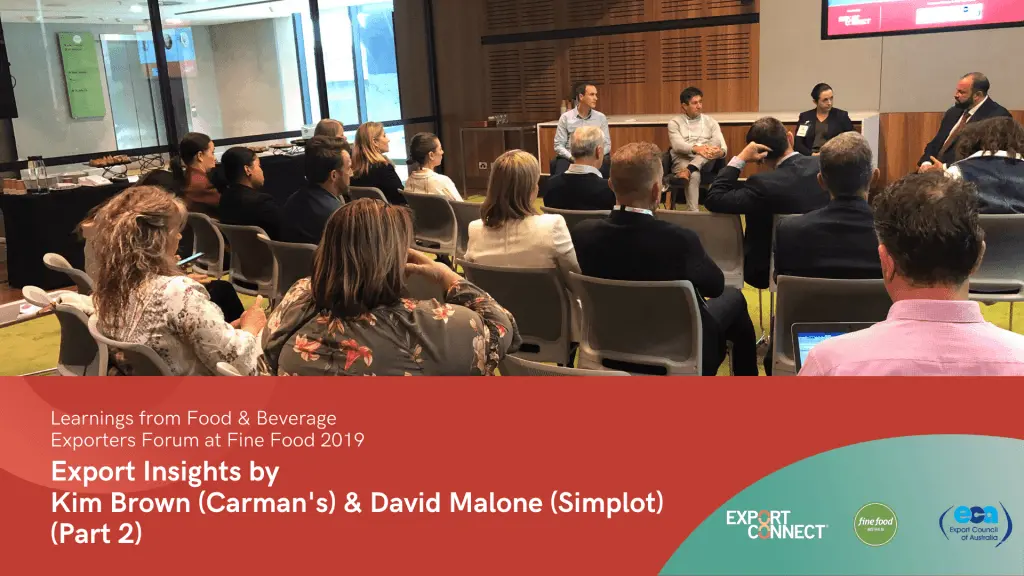At Export Connect’s recent forum at Fine Food Australia 2019, I talked to Kim Brown from Carman’s, and David Malone from Simplot about their experience managing exports for major Australian brands. In this blog, we share part 2 of the insights discussed by Kim & David:
Staying in contact with the market
Understanding your export market is absolutely essential to a successful export business – whether that’s the category, keeping healthy relationships with partners, or planning for the future – so I wanted to know how Kim and David go about staying in touch with their market and their market partners.
Both our experts advocated getting on the ground in your market and keeping abreast of what’s happening. For Kim, that means understanding the factors behind growth, supporting the local partners and visiting the market as frequently as possible. She told us Carman has seen really strong organic growth over the past 10 years, so delving into the background and consumer behaviour in markets that aren’t keeping up is really important. David’s team is visiting all markets every couple of months. For him, it is crucial to get into the stores, meet the customers, meet the buyers, work with industry and government bodies and get as full a picture as possible. That gives his business the agility to make good market decisions.
Kim also keeps in very frequent contact with her markets, but exactly what is needed is a case by case decision. She told us that for some established markets with great partner relationships and strong performance, a fortnightly phone call can be enough. For others, they might need daily work, or there may be specific projects to increase the brand’s reach like packaging or labelling. At the moment, digital brand growth across all markets is a key priority for Carman, increasing brand presence and consumer recognition.
Balancing new and existing markets
A crucial decision for any export business is to decide how much to invest in breaking new markets versus supporting existing reach. Resources for export are often tight, so I wanted to know how Kim and David see that critical balance.
David explained that their business uses a blueprint for allocating resources to new opportunities, a lot of which boils down to market attractiveness – how big are the market and category, what’s the growth rate, how profitable are existing businesses in the market, and how tough is it to break into? A big factor in that latter point is the dominance of the major players. David told us that where two or three major players have 70% + of the market wrapped up then it will be a more difficult one to break.
After assessing the market, David is also thinking about the ability of their business to win within that. Do they have a competitive advantage? How would the supply chain, and pricing work? Does the product align with core competencies? It’s only after assessing all of this that a business and resourcing decision is taken. If the market gains business approval, then it’s time for a deep dive into researching and creating a market entry plan.
Kim described a similar process – understanding the consumer, the competitive landscape, and the regulatory system. Another important point was whether the company has existing partners and network to provide a foundation to build on. From there a business proposal can be created.
For existing markets, David looks back at the original market entry plan, and checks the original assumptions have stood the test of time. Analysing market performance allows strategies to be revised, and decisions about future investment to be taken.
Kim has quarterly sit-downs with Carman’s key partners in each existing market to review performance, growth and strategy. When making investment decisions for different markets, she’s also looking at external factors – for example, political and regulatory changes. Within the market, it’s a case of assessing sales vs forecasts, growth over time, and potential impact of new products. One interesting thing Kim mentioned was that it isn’t always new products that drive growth – a solid classic product can be the top performer. Reviewing the category, looking at consumer points of view is important. Ultimately, what both Kim and David told us comes down to a key factor for all exporters – making sure priority markets and business objectives are aligned.
This forum was a great opportunity to get insights from experienced export managers for major Australian brands, and I want to thank both Kim and David for sharing their time and expertise. If you have any questions, feel free to drop us a line here at Export Connect (service@exportconnect.com.au) – we always love to hear from you.



